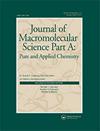新取代五叠二烯自由基聚合引发剂:合成、光化学性质及全息介质前景
IF 2.4
3区 化学
Q3 POLYMER SCIENCE
Journal of Macromolecular Science Part A-Pure and Applied Chemistry
Pub Date : 2023-09-22
DOI:10.1080/10601325.2023.2257741
引用次数: 0
摘要
摘要以芳香重氮盐和乙醇胺为原料,合成了4,4′取代的3-羟乙基戊二烯-1,4-二烯。采用紫外/可见光谱法研究了五氮杂-1,4-二烯的光解反应。给予电子的甲基和甲氧基取代基增加了光敏性,而吸电子的氯取代基具有更高的光解稳定性。在10%甲基丙烯酸甲酯溶液中,成功地研究了3-羟乙基-五氮杂-1,4-二烯作为自由基聚合引发剂。采用凝胶渗透色谱法(GPC)和差示扫描量热法(DSC)对所得聚合物的特性进行了评价。在氯取代衍生物的情况下,PMMA Mn和Đ的值最高。用532 nm激光在~ 1 μm厚的样品中记录了以偶氮染料掺杂PMMA为基料的平面波前全息图。平行偏振光的衍射效率值在Cl→Me→OMe串联中增大。关键词:偶氮染料全息衍射效率;自由基聚合引发剂;公开声明;本文章由计算机程序翻译,如有差异,请以英文原文为准。
New substituted pentazadienes as initiators of free-radical polymerization: synthesis, photochemical properties and perspectives for holographic media
AbstractThe series of 4,4′-substituted 3-hydroxyethyl-pentaza-1,4-dienes were synthesized in the reaction of aromatic diazonium salts with an ethanol amine. Photolysis of pentaza-1,4-dienes was investigated by means of UV/Vis spectroscopy. Electron donating methyl and methoxy substituents were found to increase photosensitivity whereas electron withdrawing chloro-substituents cause higher photolytic stability. 3-hydroxyethyl-pentaza-1,4-dienes as a radical polymerization initiator has been successfully investigated in 10% methyl methacrylate solution in DMF. Gel permeation chromatography (GPC) and differential scanning calorimetry (DSC) were used for obtained polymers characteristics evaluation. The highest values of PMMA Mn and Đ can be obtained in the case of chloro-substituted derivative. The holograms of a plane wavefront were recorded in media based on obtained PMMA doped by azo-dye by a 532 nm laser in a ∼1-μm-thick sample. The diffraction efficiency values for parallel polarized acting light increased in Cl→Me→OMe series.Keywords: Azo dyesholographydiffraction efficiencyPMMAradical polymerization initiator Disclosure statementThere are no conflicts to declare.
求助全文
通过发布文献求助,成功后即可免费获取论文全文。
去求助
来源期刊
CiteScore
4.60
自引率
16.00%
发文量
61
审稿时长
3.1 months
期刊介绍:
Journal of Macromolecular Science, Part A: Pure and Applied Chemistry (JMS-PAC) is a necessary resource for academic and industrial scientists and engineers whose interests center on both synthetic and naturally occurring polymers and their applications.

 求助内容:
求助内容: 应助结果提醒方式:
应助结果提醒方式:


